At the Center for Folklife and Cultural Heritage, we have been thinking a lot about assessing the long-term impact of our work. How does the Center support community agency? How do we learn through reciprocal engagement? How can we better support cultural sustainability of the communities with which we work?
These concepts are often cited as principles of the work we do. My personal preoccupation has been with the ways which we can communicate and pass on the collective knowledge and expertise born of almost fifty years of researching, curating, and producing Folklife Festivals. There are several arenas in which the Festival has operated as a small-scale laboratory: cultural tourism, community-generated cultural documentation efforts, creative industries, K-12 education, public programs, and cultural heritage professional training. These cumulative experiences have also contributed to advising creation of policies governing intangible cultural heritage.
In January 2014 I traveled with fellow Smithsonian curator and anthropologist Dr. Mary Jo Arnoldi from the National Museum of Natural History to Mali, to facilitate a series of sessions on fostering community engagement for cultural professionals from regional museums throughout francophone West Africa. The workshops took place at the National Museum in Bamako, as part of a “Managing Museums in the Face of Conflict” training program organized by the International Council on Museums (ICOM), in partnership with the Smithsonian and with support from UNESCO and the French Ministry of Culture and Communication.
The participants included staff from museums and libraries of Timbuktu, Gao, and Djenne—impacted most directly by the conflict in the north, plus museum directors from Burkina Faso, Guinea, Ivory Coast, Mauritania, and Senegal. The overall history and goals of the training sessions were to encourage museums in the region to develop strategic plans for safeguarding their collections in the event of conflict.

On the first day, we were welcomed by Dr. Samuel Sidibe, director and curator in chief of the National Museum of Mali, and Minister of Culture Bruno Maiga. Sidibe was co-curator of the 2003 Smithsonian Folklife Festival program on Mali along with Arnoldi and John Franklin. He spoke eloquently and poignantly about the impact of the Malian conflict on the National Museum and the Museum’s mission to educate and sensitize the international community.
The two-day session that Arnoldi and I facilitated focused on the importance of imparting a sense of community ownership of the museum, revisiting relationships with community constituents, and developing a long-term commitment to reciprocal engagement with residents of the surrounding areas. The aim was to see museums as participatory, integral to the community life, as sites of dialogue and exploration of shared humanity and experience worth saving. The two days were premised on the idea that these museum-community relationships were among the best protection for museums in conflict, but that they must be established well before a crisis occurs.
During the workshop, participants identified their communities’ assets and pressing issues. We asked, “What keeps you up at night?” Rich discussion ensued about the challenges of running a museum in a region where there is no traditional counterpart, where museums were historically associated with colonial occupation. We examined strategies that we had all used: including and engaging the community in the museum and connecting the collections and the people. Arnoldi described the involvement of the Somali immigrant community in building an aqual (traditional Somali dwelling constructed by women) for the African Voices exhibition as a case study in making links between collections and people.

After discussion, we asked participants to select objects in the adjacent galleries and describe ways in which they might build community projects around them. This exercise was challenging for the museum directors and curators, many of whom were accustomed to describing and interpreting the objects for visitors, or demonstrating their knowledge of objects in their collections to their academically trained colleagues. The group brainstormed new strategies for approaching the community and engaging individuals and groups drawing on their collective base of experiences.
In the final presentation, we focused on how to create networks, partnerships, and share resources across museums. The sessions were engaging for us and, from the evaluations, appear to have been beneficial for participants as well. In the larger sense, though, we still wonder, what is the capacity of cultural institutions to influence economies? What role should museums to play in peacemaking, either in civil society or at the state level? How can museums best support local communities in creating safe spaces that nurture respect, appreciation, and mutual cooperation, that transcend points of difference—not only in Mali, but in the United States as well?
Diana N’Diaye is a curator at the Center for Folklife and Cultural Heritage.


